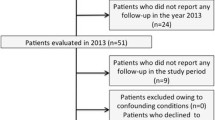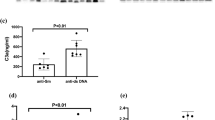Abstract
Objectives
Pentraxin 3 (PTX3) plays an important role in inflammation, immunity, and atherosclerosis. Plasma PTX3 level has drawn attention as a marker that responds to local inflammation. Systemic lupus erythematosus (SLE), a chronic inflammatory disorder which can affect multiple organs, develops atherosclerosis prematurely. We examined the hypotheses that the concentration of plasma PTX3 increases in patients with SLE and that PTX3 is associated with the disease activity and premature atherosclerosis.
Methods
Plasma PTX3 concentrations were measured in 65 patients with SLE and 53 control subjects. The patients were also evaluated with respect to their clinical characteristics, disease activity indices, and corticosteroid therapy. We performed carotid ultrasonography to measure subclinical atherosclerosis in patients with SLE.
Results
Plasma PTX3 concentration of the SLE patients was significantly higher than that of the healthy controls (median 3.9 vs. 2.0 ng/mL, p < 0.001). In patients with SLE, PTX3 concentrations were correlated with SLEDAI (p = 0.011), BILAG index (p < 0.001), C-reactive protein (p < 0.001), anemia (p = 0.020), hypoalbuminemia (p = 0.022), and daily dose of prednisolone (p = 0.008) after adjustment for age and sex. PTX3 was not associated with disease duration, anti-ds DNA antibody, CH50, or carotid atherosclerosis.
Conclusions
Patients with SLE have increased concentrations of PTX3 compared with control subjects. PTX3 was significantly associated with disease activity but not with carotid atherosclerosis.

Similar content being viewed by others
References
Cieślik P, Hrycek A. Long pentraxin 3 (PTX3) in the light of its structure, mechanism of action and clinical implications. Autoimmunity. 2012;45:119–28.
Mantovani A, Garlanda C, Doni A, Bottazzi B. Pentraxins in innate immunity: from C-reactive protein to the long pentraxin PTX3. J Clin Immunol. 2008;28:1–13.
Deban L, Jaillon S, Garlanda C, Bottazzi B, Mantovani A. Pentraxins in innate immunity: lessons from PTX3. Cell Tissue Res. 2011;343:237–49.
Luchetti MM, Piccinini G, Mantovani A, Peri G, Matteucci C, Pomponio G, et al. Expression and production of the long pentraxin PTX3 in rheumatoid arthritis (RA). Clin Exp Immunol. 2000;119:196–202.
Dagna L, Salvo F, Tiraboschi M, Bozzolo EP, Franchini S, Doglioni C, et al. Pentraxin-3 as a marker of disease activity in Takayasu arteritis. Ann Intern Med. 2011;155:425–33.
Fazzini F, Peri G, Doni A, Dell’Antonio G, Dal Cin E, Bozzolo E, et al. PTX3 in small-vessel vasculitides: an independent indicator of disease activity produced at sites of inflammation. Arthritis Rheum. 2001;44:2841–50.
Garlanda C, Hirsch E, Bozza S, Salustri A, De Acetis M, Nota R, et al. Non-redundant role of the long pentraxin PTX3 in anti-fungal innate immune response. Nature. 2002;420:182–6.
Muller B, Peri G, Doni A, Torri V, Landmann R, Bottazi B, et al. Circulating levels of the long pentraxin PTX3 correlate with severity of infection in critically ill patients. Crit Care Med. 2001;29:1404–7.
Peri G, Introna M, Corradi D, Iacuitti G, Signorini S, Avanzini F, et al. PTX3, a prototypic long pentraxin, is an early indicator of acute myocardial infarction in humans. Circulation. 2000;102:636–41.
Rolph MS, Zimmer S, Bottazzi B, Garlanda C, Mantovani A, Hansson GK. Production of the long pentraxin PTX3 in advanced atherosclerotic plaques. Arterioscler Thromb Vasc Biol. 2002;22:10–4.
Asanuma Y, Oeser A, Shintani AK, Turner E, Olsen N, Fazio S, et al. Premature coronary-artery atherosclerosis in systemic lupus erythematosus. N Engl J Med. 2003;349:2307–15.
Esdaile JM, Abrahamowicz M, Grodzicky T, Li Y, Panaritis C, du Berger R, Côte R, et al. Traditional Framingham risk scores fail to fully account for accelerated atherosclerosis in systemic lupus erythematosus. Arthritis Rheum. 2001;44:2331–7.
Ross R. Atherosclerosis—an inflammatory disease. N Engl J Med. 1999;340:115–26.
Tan EM, Cohen AS, Fries JF, Masi AT, McShane DJ, Rothfield NF, et al. The 1982 revised criteria for the classification of systemic lupus erythematosus. Arthritis Rheum. 1982;25:1271–7.
Hochberg MC. Updating the American College of Rheumatology revised criteria for the classification of systemic lupus erythematosus. Arthritis Rheum. 1997;40:1725.
Gladman DD, Ibañez D, Urowitz MB. Systemic lupus erythematosus disease activity index 2000. J Rheumatol. 2002;29:288–91.
Simmons DP, Coppock JS, Bacon PA, Bresnihan B, Isenberg DA, Maddison P, et al. Development and assessment of a computerized index of clinical disease activity in systemic lupus erythematosus. Members of the British Isles Lupus Assesment Group (BILAG). Q J Med. 1988;69:927–37.
Gladman DD, Urowitz MB. The SLICC/ACR damage index: progress report and experience in the field. Lupus. 1999;8:632–7.
ACR AD HOC Committee on Neuropsychiatric Lupus Nomenclature. The American College of Rheumatology nomenclature and case definitions for neuropsychiatric lupus syndromes. Arthritis Rheum. 1999;42:599–608.
Weening JJ, D’Agati VD, Schwartz MM, Seshan SV, Alpers CE, Appel GB, et al. The classification of glomerulonephritis in systemic lupus erythematosus revised. J Am Soc Nephrol 2004;15:241–50 (Erratum in: J Am Soc Nephrol. 2004;15:835–6).
Inoue K, Sugiyama A, Reid PC, Ito Y, Miyauchi K, Sagara M, et al. Establishment of a high sensitivity plasma assay for human pentraxin3 as a marker for unstable angina pectoris. Arterioscler Thromb Vasc Biol. 2007;27:161–7.
Yamasaki K, Kurimura M, Kasai T, Sagara M, Kodama T, Inoue K. Determination of physiological plasma pentraxin 3 (PTX3) levels in healthy populations. Clin Chem Lab Med. 2009;47:471–7.
Hollan I, Bottazzi B, Cuccovillo I, Forre OT, Mikkelsen K, Saatvedt K, et al. Increased levels of serum pentraxin 3, a novel cardiovascular biomarker, in patients with inflammatory rheumatic disease. Arthritis Care Res. 2010;62:378–85.
Kim J, Koh JK, Lee EY, Park JA, Kim HA, Lee EB, et al. Serum levels of soluble triggering receptor expressed on myeloid cells-1 (sTREM-1) and pentraxin 3 (PTX3) as markers of infection in febrile patients with systemic lupus erythematosus. Clin Exp Rheum. 2009;27:773–8.
Rezaieyazdi Z, Sahebari M, Hatef MR, Abbasi B, Tafatpanah H, Afshari JT, et al. Is there any correlation between high sensitive CRP and disease activity in systemic lupus erythematosus? Lupus. 2011;20:1494–500.
Keenan RT, Swearingen CJ, Yazici Y. Erythrocyte sedimentation rate and C-reactive protein levels are poorly correlated with clinical measures of disease activity in rheumatoid arthritis, systemic lupus erythematosus and osteoarthritis patients. Clin Exp Rheumatol. 2008;26:814–9.
Griffiths B, Mosca M, Gordon C. Assessment of patients with systemic lupus erythematosus and the use of lupus disease activity indices. Best Pract Res Clin Rheumatol. 2005;19:685–708.
Ho A, Barr SG, Magder LS, Petri M. A decrease in complement is associated with increased renal and hematologic activity in patients with systemic lupus erythematosus. Arthritis Rheum. 2001;44:2350–7.
Hanly JG, Urowitz MB, Su L, Gordon C, Clarke A, Bernatsky S, et al. Antoantibodies as biomarkers for the prediction of neuropsychiatric events in systemic lupus erythematosus. Ann Rheum Dis. 2011;70:1726–32.
Doni A, Mantovani G, Porta C, Tuckermann J, Reichardt HM, Kleiman A, et al. Cell-specific regulation of PTX3 by glucocorticoid hormones in hematopoietic and nonhematopoietic cells. J Biol Chem. 2008;283:29983–92.
Acknowledgments
The authors thank Dr. Daisuke Ikuma, Ms. Yukari Yamada and Ms. Kozue Watanabe for their technical support. We also appreciate Ms. Yoshimi Aizaki for her secretarial assistance. Dr. Asanuma was partly supported by research grants from The Ministry of Education, Culture, Sports, Science and Technology of Japan.
Conflict of interest
None.
Author information
Authors and Affiliations
Corresponding author
About this article
Cite this article
Shimada, Y., Asanuma, Y.F., Yokota, K. et al. Pentraxin 3 is associated with disease activity but not atherosclerosis in patients with systemic lupus erythematosus. Mod Rheumatol (2013). https://doi.org/10.1007/s10165-013-0830-2
Received:
Accepted:
Published:
DOI: https://doi.org/10.1007/s10165-013-0830-2




